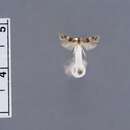Comprehensive Description
provided by Smithsonian Contributions to Zoology
Asymphorodes acritopterus
Alar expanse 8–12 mm.
Labial palpus second segment light buff with fuscous mark at base and a fuscous annulus at apex; third segment fuscous. Antenna fuscous; scape with a small buff spot dorsodistally. Head fuscous; face buff. Thorax and tegula fuscous; thornlike processes from metascutum of male present. Forewing ground color in basal half fuscous overlaid proximally with grayish scales; ground color of outer half mostly grayish; on costa beyond basal patch, a buff spot, this followed by a fuscous subtriangular mark, the latter based on costa, which fuses with a fuscous subquadrate mark at end of cell; along termen a fuscous line with usually three small buff spots along its outer edge; cilia grayish fuscous. Hindwing grayish; cilia a shade lighter. Foreleg, midleg, and hindleg buff, marked with fuscous. Abdomen grayish fuscous dorsally, ventrally buff; terminal segments of male strikingly modified (Figure 186c–e).
Male genitalia slides USNM 24651, 24662, 24663. Harpe with broad base; neck half as long as basal portion, narrow; cucullus slightly expanded. Brachia bent before middle; right brachium arising from a broad base and curved transversely touching left brachium; right brachium longer than left. Tegumen about as long as broad. Aedeagus S-shaped, slender; manica with subtriangular keel dorsodistally.
Female genitalia slides USNM 24664, 24665. Ostium small, round, emerging from a bulbous process set in base of asymmetrical pit in posterior edge of 7th sternum. Inception of ductus seminalis from posterior edge of bursa copulatrix. Ductus bursae membranous anteriorly, strongly sclerotized in posterior half. Bursa copulatrix membranous.
HOLOTYPE.—USNM 100815.
TYPE-LOCALITY.—Fatu Hiva, Omoa.
DISTRIBUTION.—Fatu Hiva.
FOOD PLANT.—Unknown.
Described from the holotype (17 Mar 1968), 9 and 23 paratypes all from Fatu Hiva, Omoa, 14 Mar to 10 Apr 1968.
This is very similar to the foregoing, circopis, from which it is distinguished as discussed under that species. All of the specimens of acritopterus were collected at practically sea level, and the species appears to be confined to Fatu Hiva.
- bibliographic citation
- Clarke, J. F. Gates. 1986. "Pyralidae and Microlepidoptera of the Marquesas Archipelago." Smithsonian Contributions to Zoology. 1-485. https://doi.org/10.5479/si.00810282.416
Asymphorodes acritopterus: Brief Summary
provided by wikipedia EN
Asymphorodes acritopterus is a moth of the family Agonoxenidae. It was described by John Frederick Gates Clarke in 1986. It is found in French Polynesia.
- license
- cc-by-sa-3.0
- copyright
- Wikipedia authors and editors

